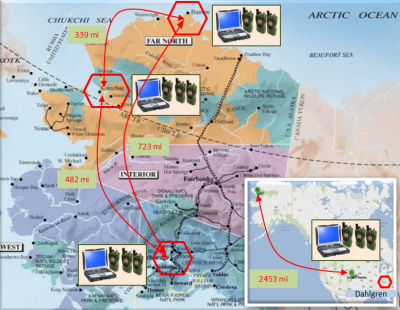
DAHLGREN, Va.—Navy engineers scattered across Alaska's polar region successfully communicated to their counterparts in the continental United States for the first time under austere weather conditions with handheld Distributed Tactical Communications System (DTCS) Phase 3 radios, the Navy DTCS program office announced Nov. 21.
The civilian engineers—testing DTCS over thousands of miles in November—confirmed its new global range capability over a multi-satellite, multi-spot beam architecture that will enhance command and control for U.S. Northern Command and U.S. European Command.
"We provided the ability for personnel to communicate in the polar regions above the Arctic Circle and provide reach-back, a paramount capability that otherwise does not exist at the tactical level," said DTCS Technical Manager Igor Marchosky. "We tested the global architecture part of the DTCS system, and it worked as designed."
The engineers maintained continuous communications between three DTCS testing sites in Alaska (Barrow, Kotzebue, and Anchorage) and two sites in the continental United States—U.S. Northern Command (NORTHCOM) headquarters, Colorado Springs, Colo., and the Naval Surface Warfare Center Dahlgren Division (NSWCDD), Dahlgren. Va.
"In spite of inclement weather and the elements of the polar region environment, we all had casual, normal conversation among the sites," said DTCS Program Manager Nathan Rodecap.
DTCS Phase 3—leveraging the Iridium low earth orbiting satellite constellation—ensures coverage above the Arctic Circle, eliminating shortfalls and supplementing areas in which current systems are not reliable.
"We sustained voice communications, chat sessions, and position location information transmission to and from every site," said Marchosky, co-located with Rodecap and Rear Adm. Thomas H. "Hank" Bond, Jr., NORTHCOM Command and Control Systems Director at the Colorado Springs site during the testing.
DTCS, developed by NSWCDD and Marine Corps Warfighting Laboratory scientists and engineers, is the result of commercial off-the-shelf parts and applied science, technology, and systems integration. It was designed to ensure reliable connections with a constellation of 66 satellites providing global availability for joint forces on the ground, in vehicles, aboard aircraft—and now in the polar region—via Iridium-based radios that provide on-the-move, over-the-horizon, beyond line-of-sight voice and position location information without the need for local ground infrastructure.
"The Phase 3 capability will be adopted by all combatant commands and used in a wider range of missions such as continuous, robust, Arctic communications," said DTCS Deputy Technical Manager John Giscard, who tested the system on site with Joint Task Force Alaska (JTF-Alaska) leadership in Anchorage. "Its global communications can be applied to search and rescue, ship patrols, and natural disasters when responders' line of sight won't work as well."
The capability also provides greater capacity and interoperability with legacy services.
"This demonstration builds confidence that we can leverage the available capabilities of Iridium to address critical communications gaps and add resiliency to our communications networks at a very effective cost point and on accelerated timelines in comparison to flying military-unique constellations," said Robert Gold, DoD Information Systems and Cyber Security Director.
Since NSWCDD engineers developed DTCS seven years ago, warfighters in Afghanistan and Iraq received more than 7,000 Phase 2 tactical radios.
The two previous phases of DTCS responded to shortfalls for mobile users. Specifically, Phases 1 and 2 provided satellite communications to users who did not previously have instant mobile access to a global communications system.
The new phase builds upon the satellite communications capability by increasing range, capacity, reliability and utility.
"Phase 3 testing demonstrated the global architecture," said Rodecap. "We've been successful in each prior phase, and we also expect to be successful in the evaluation and operationalization of Phase 3."
Once operational, DTCS Phase 3 is expected to enable communications everywhere at any time, closing the digital divide and providing access to all from users on the ground to disadvantaged warfighters who lack good communications.
"The DTCS Phase 3 demonstration at NSWC Dahlgren showed how an innovative and unique application of commercial space systems can be utilized to bring broad area command and control capability to the tactical level," said Navy Capt. Bruce Dickey, Program Executive Office Space Systems Technical Advisor.
This is good news for warfighters at the tactical edge who can be separated from the greater global information grid due to the inherent challenges of critical bidirectional information flow. Their needs can now be met with lightweight, resilient, and capable systems that leverage leading industry designs, components, and manufacturing methods.
"In order to close the gap of the 'tactical' digital divide, warfighters must be presented with the information they need, whenever they need it, and however they need it, while injecting the appropriate information needed at the operational level," said Marchosky.


